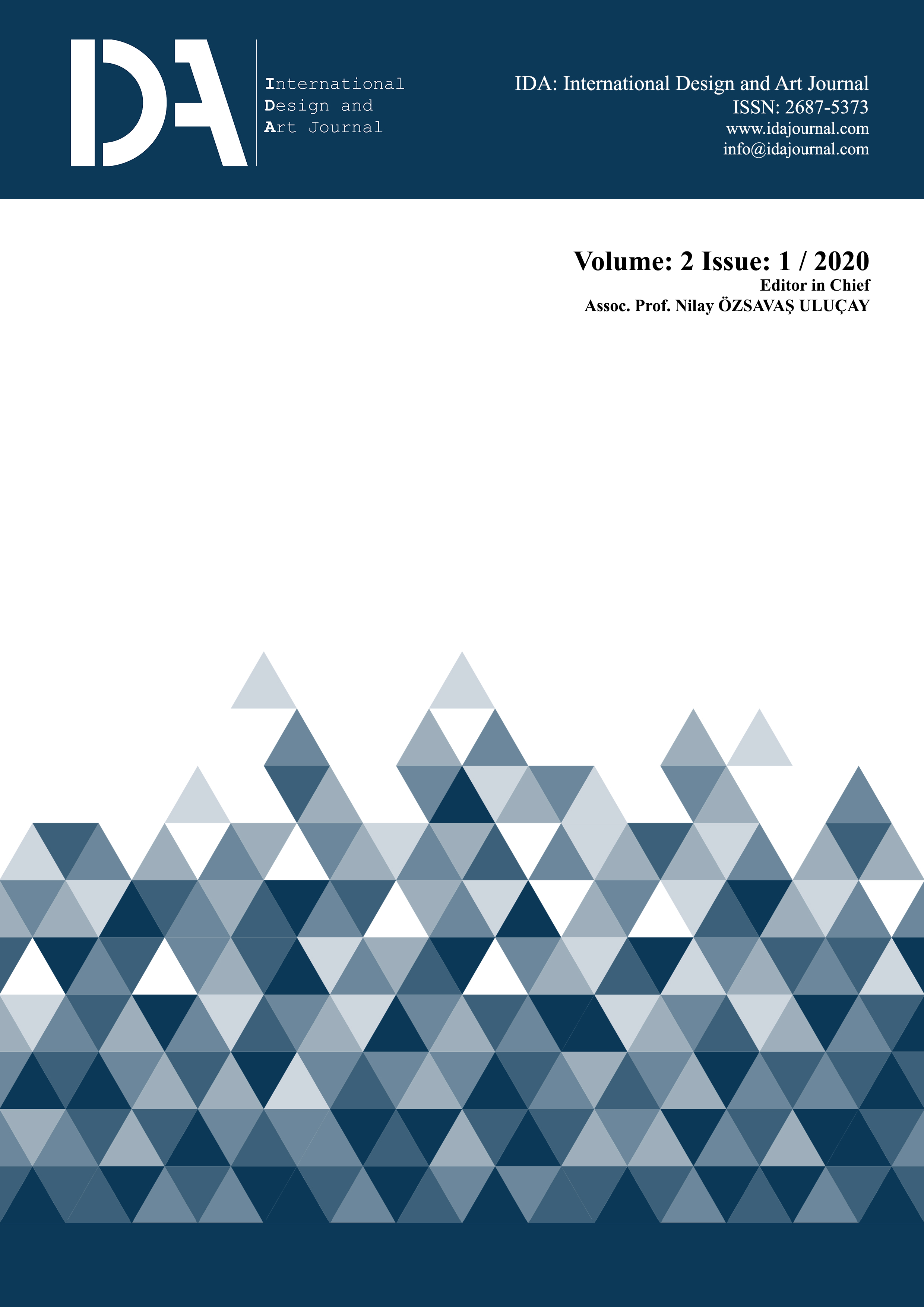Evaluation of the Reintegration Method in Leather Artefact According to the Protection Approaches
Keywords:
Leather, Artefact, Preservation, Restoration, ReintegrationAbstract
The usage of the leather was developed in parallel with human evolution. People benefitted from leather’s unique features and used this readymade for various purposes. Leather is a natural and durable material acquired from peltries’ dermis layer. Since these animal products completely consist of protein collagen, it gathers its strength from the collagen fibers. Leather objects contain works that made using skins, textures and inner membranes of animals. Alongside the works made with tanned leathers using various methods, parchment, intestines or raw materials gathered from leather are also among these objects. There are many historical leather artifacts that need to be protected such as clothings and book bindings in museums and libraries. However, like in all organic based products, natural decay is a part of this project and should not be accepted as stabile in long term. From the moment it was separated from the animal, leather tends to decay and preserved with active and passive conservation methods. Since each preservation treatment requires special solutions depending on the leather’s unique structure, when it comes to leather, treatment options are limited. Therefore, the selection of each and every one of the treatment of conservation on leather is an important issue. This study gathers the data acquired from conservation literature and evaluates the reintegration process which is among the active conservation practices and aims to determine the techniques and materials used in the reintegration of the leather works. The reintegration methods of the leather pieces were grouped by the guidelines and principles that are bases of the contemporary conservation theory and determined by the Carta Del Restauro (1931) and the Venetian Code (1961). Materials and techniques that were used in leather’s consolidation and in lacking pieces of it were determined. Leather, textile, paper, filling and coating materials, natural adhesives or adhesives prepared with various mixtures are used. Different techniques are applied according to the conservation status, historical, technical and artistic importance of the work and the size and quality of the missing areas. Leather works are repaired with partial or support, formal, decorative, mimetic completion techniques. Leather repairs made with traditional methods for many years continue with the development of technology, depending on the new techniques and materials. It is thought that the study, which is considered important for the protection of leather works, will contribute to the field.
References
Ahunbay, Z. (2009). Tarihi Çevre Koruma ve Restorasyon. İstanbul: YEM Yayın.
Ahunbay, Z. (2019). Kültür Mirasını Koruma İlke ve Teknikleri. İstanbul: YEM Yayın.
AIC- Amerikan Koruma Enstitüsü. (2019). https://www.culturalheritage.org/ (20.12.2019)
AIC- Amerikan Koruma Enstitüsü. (2020). https://www.culturalheritage.org/ (20.12.2019)
Anderson, P. and Reidell, S. (2009). Adhesive Pre-Coated Repair Materials. Book and Paper Group, LCCDG and ACDG.
Çınar N. ve Büyükyazıcı M. (2017). Türk Cilt Sanatında Kullanılan Deriler ve Özellikleri. TİDSAD (Türk & İslam Dünyası Sosyal Araştırmalar Dergisi), 4(11), s.256-275.
Çınar, N. (2017). El Yazma Eserlerin Ciltlerinde Kullanılan Deriler Üzerine Bir Araştırma, Yüksek Lisans Tezi, Gazi Üniversitesi, Güzel Sanatlar Enstitüsü, Geleneksel Türk Sanatları Anasanat Dalı, Ankara.
Eskici, B. (1997). Tas Eserlerin Korunması Üzerine Notlar. Türk Arkeoloji Dergisi, Kültür Bakanlığı Anıtlar ve Müzeler Genel Müdürlüğü, S.XXXI, s. 383-391. Ankara.
Eskici, B. (2018). Seramik Onarımlarında Bütünleme Yöntemleri Üzerine Bir Değerlendirme. Sanat ve Tasarım Dergisi, 22, s.135-153. https://dergipark.org.tr/tr/pub/sanatvetasarim/issue/41779/504064
Girard, S. (2018). BEVA 371-based Synthetic Leather. Journal of Paper Conservation, 19(1), s.18-32. DOI: 10.1080/18680860.2018.1521018.
Grace O., Reidell, S. (2010). Cast Composites: A System for Texturing Repair Materials in Book Conservation. Book and Paper Group Annual, 29, s.92-93, s.98-105.
Harmancıoğlu, M., Dikmelik, Y. (1993). Ham Deri, Yapısı Bileşimi Özellikleri. Sepici Şirketler Topluluğu Kültür Hizmeti, İzmir: Özen Ofset.
Kılıçoğlu, S. (1993). Ham Deri. İstanbul: Dericilik Araştırma Enstitüsü Yayınları.
Kite, M., Thomson, R., Angus, A. (2006). Materials and Techniques: Past and Present. Conservation of Leather and Related Materials, Butterworth-Heinemann is an imprint of Elsevier, s.121-130.
Knight, E., (2016). Assaying Klucel-G Recipes. Application Methods in the Surface Consolidation of Tanned Bookbinding Leathers [Poster], Boston Athenæum.
Kuban, D. (2000). Tarihi çevre Korumanın Mimarlık Boyutu Kuram ve Uygulama. İstanbul: YEM-Yapı Endüstri Merkezi Yayınları.
Ludwick, L. (2012). A Comparative Study on Surface Treatments in Conservation of Dry Leather, with Focus on Silicone Oil. Uppsats För Avläggande Av Filosofie Kandidatexamen İ Kulturvård, Konservatorprogrammet 15 Hp Institutionen För Kulturvård Göteborgs Universitet.
NPS Museum Handbook, Part I, (1996). Curatorial Care of Objects and Skin Products Made From Leather. United States Department of the Interior, National Park Service P. O. Box 37 127, Washington.
Owen, G. and Reidell, S. (2011). Cast Composites: A System for Texturıng Repair Materials in Book Conservationt. AIC-The American Institute for Conservation of Historic & Artistic Works, Topics in Photographic Preservation, 14, p.250-262.
Öncü, C. (1968). Dericilik Temel Bilgileri, Mezbaha Mahsulleri Teknolojisi. Ankara: Ankara Üniversitesi Ziraat Fakültesi Yayınları.
Şenses, İ. U. (1993). Deri Teknolojisi I, İstanbul.
TAEK, 2019. Ciltte Tamamlama. Türkiye Yazma Eserler Kurumu Başkanlığı, Kitap Şifahanesi ve Arşiv Dairesi Başkanlığı, http://www.kitapsifahanesi.yek.gov.tr/ ( 17.11.2019).
Toptaş, A. (1993). Deri Teknolojisi. İstanbul Üniversitesi, Teknik Bilimler Meslek Yüksekokulu, Dericilik Programı, İstanbul: Sade Ofset Matbaacılık.
Toptaş, A. (1998). Deride Kalite Tespiti, İstanbul Üniversitesi Dericilik Araştırma, Geliştirme ve Eğitim Merkezi, İstanbul: Sade Ofset Matbaacılık.
Venedik Tüzüğü (1964). http://www.icomos.org.tr/Dosyalar/ICOMOSTR_tr0243603001536681730.pdf
Yakalı T. ve Dikmelik Y. (1994). Deri Teknolojisi Yaş İşlemler. Teknik Ofset. İzmir: Sepici Kültür Hizmeti Yayınları.
Waterer, J. W. (1972). A Guide to the Conservation and Restoration of Objects Made Wholly or in Part of Leather. New York: Drake Publishers.
Downloads
Published
Issue
Section
License
IDA: International Design and Art Journal is an open-access academic journal. All publishing rights of the accepted articles are deemed to assign to IDA: International Design and Art Journal. Articles can not be published and copied anywhere, and can not be used without reference.
IDA: International Design and Art Journal is licensed under a Creative Commons Attribution-NonCommercial-ShareAlike 4.0 International License.



